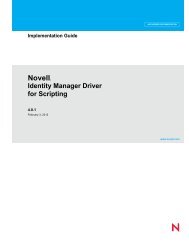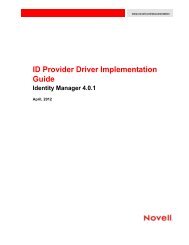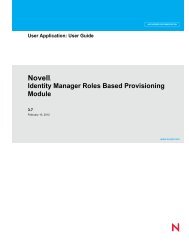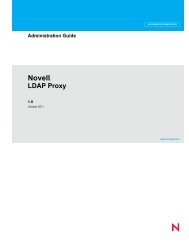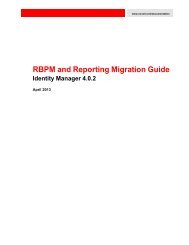Novell eDirectory 8.8 Troubleshooting Guide - NetIQ
Novell eDirectory 8.8 Troubleshooting Guide - NetIQ
Novell eDirectory 8.8 Troubleshooting Guide - NetIQ
Create successful ePaper yourself
Turn your PDF publications into a flip-book with our unique Google optimized e-Paper software.
obituaries are removed after the Primary obituary is ready to be removed or, in the case of<br />
Inhibit_move, the Tracking obituary is removed after the Primary obituary has moved to the<br />
OBF_NOTIFIED state on the master replica.<br />
The replica responsible for processing obituaries does so on a background process (the Obituary<br />
Process), which is scheduled on a per-partition basis after a given partition finishes an inbound<br />
synchronization cycle. If there are no other replicas of the partition, the Outbound Replication<br />
Process is still scheduled on the heartbeat interval. The Outbound Replication Process then starts the<br />
Obituary Process. The Obituary Process cannot be manually scheduled, nor does it need to be. As<br />
synchronization occurs, the transitive vectors are updated, thus advancing the Purge Vector and Obit<br />
Vector. As these vectors move forward, the obituary states are allowed to move forward. This,<br />
together with the automatic scheduling done upon inbound synchronization, completes the obituary<br />
processing cycle. Therefore, the lifeblood of obituary processing is object synchronization.<br />
novdocx (en) 22 June 2009<br />
For an object that is being removed, after all obituaries whose associated Primary obituary is of type<br />
Dead have been advanced to the last state (Purgeable), and that state has been synchronized to all<br />
replicas, a new process is responsible for removing the remaining entry husk from the database. The<br />
Purge Process runs automatically to remove these husks. You can manually schedule the Purge<br />
Process and modify its automatic schedule interval by using the Agent Configuration page in<br />
iMonitor.<br />
9.1 Examples<br />
This section contains the following examples:<br />
• “Deleting an Object” on page 54<br />
• “Moving an Object” on page 55<br />
9.1.1 Deleting an Object<br />
1 Add the Primary obituary OBT_DEAD.<br />
The Back Link attribute contains a list of servers that have an interest in this object and need to<br />
be notified of changes to this entry. For every DN listed in the Back Link attribute and all<br />
servers listed in the entry's partition replica attribute, <strong>eDirectory</strong> adds a Back Link obituary.<br />
The creation time of the Primary obituary, OBT_DEAD, is stored in the Secondary obituary.<br />
The Used By attribute contains a list of partitions that have an interest in this object and need to<br />
be notified of changes to this entry. For every DN listed in the Used By attribute, <strong>eDirectory</strong><br />
adds a Used By obituary. The creation time of the Primary obituary, OBT_DEAD, is stored in<br />
the Secondary obituary.<br />
2 Remove all attributes but the obituaries.<br />
The Outbound Replication Process then synchronizes this change to all other servers in the<br />
replica ring.<br />
On the next inbound synchronization of this partition, the Obituary Process is started, which<br />
does the following:<br />
• Computes a time vector which is a minimum transitive vector, referred to as the purge<br />
vector. Later versions of <strong>eDirectory</strong> compute a second minimum vector, called the<br />
obituary vector, which does not consider replicas which are subordinate references.<br />
• Each Obituary in this partition is now examined.<br />
54 <strong>Novell</strong> <strong>eDirectory</strong> <strong>8.8</strong> <strong>Troubleshooting</strong> <strong>Guide</strong>




